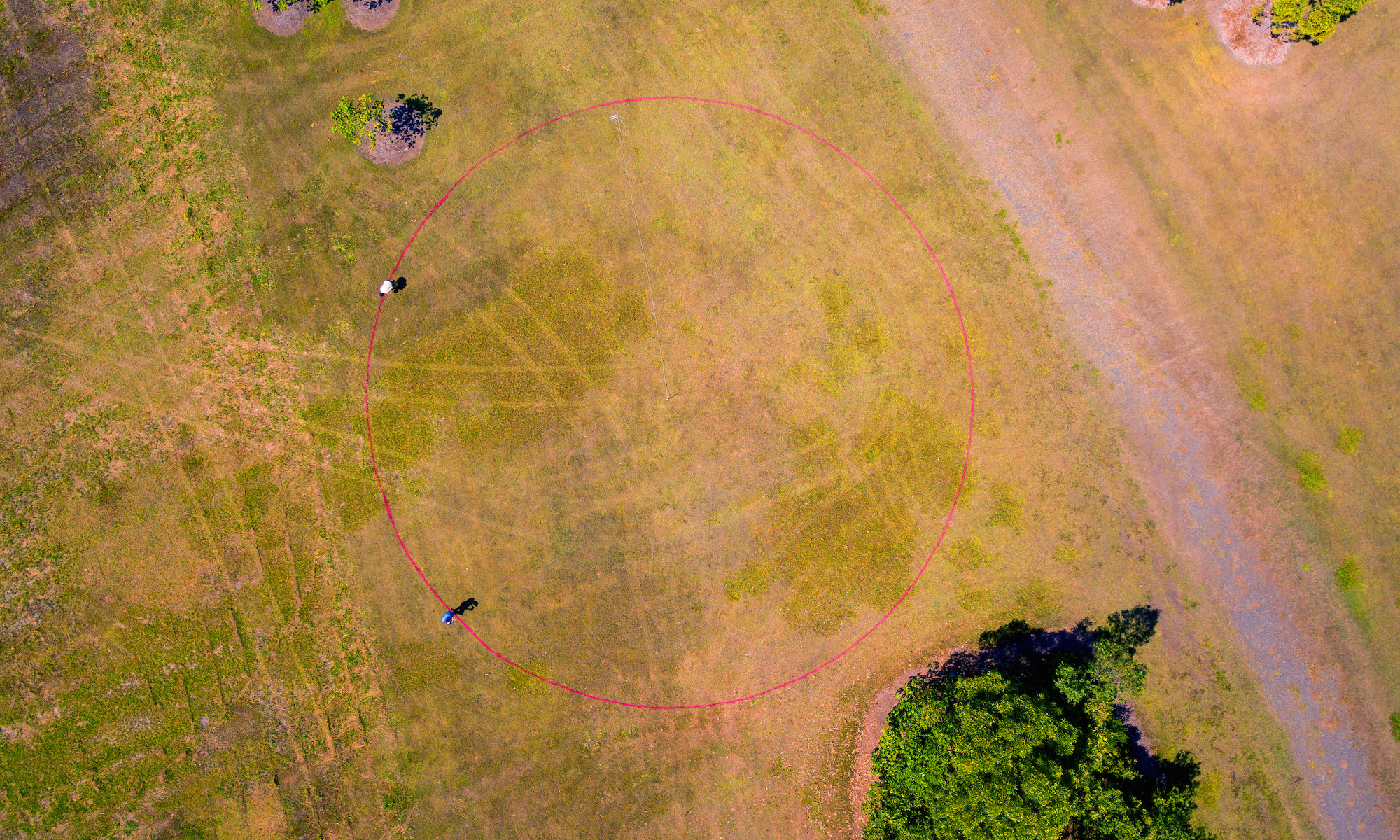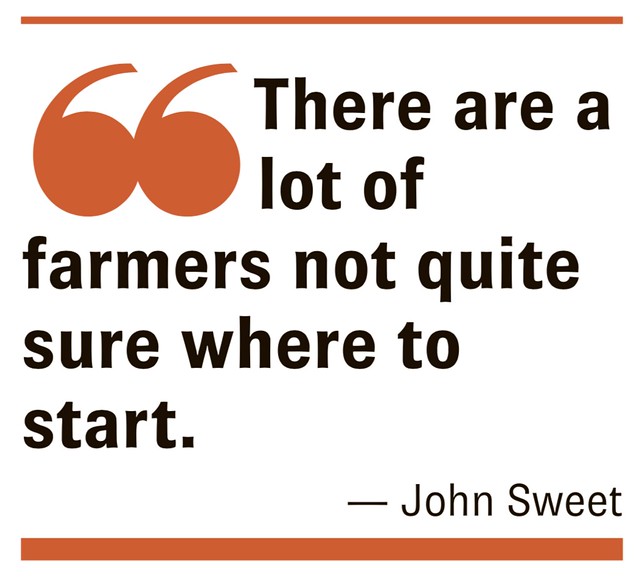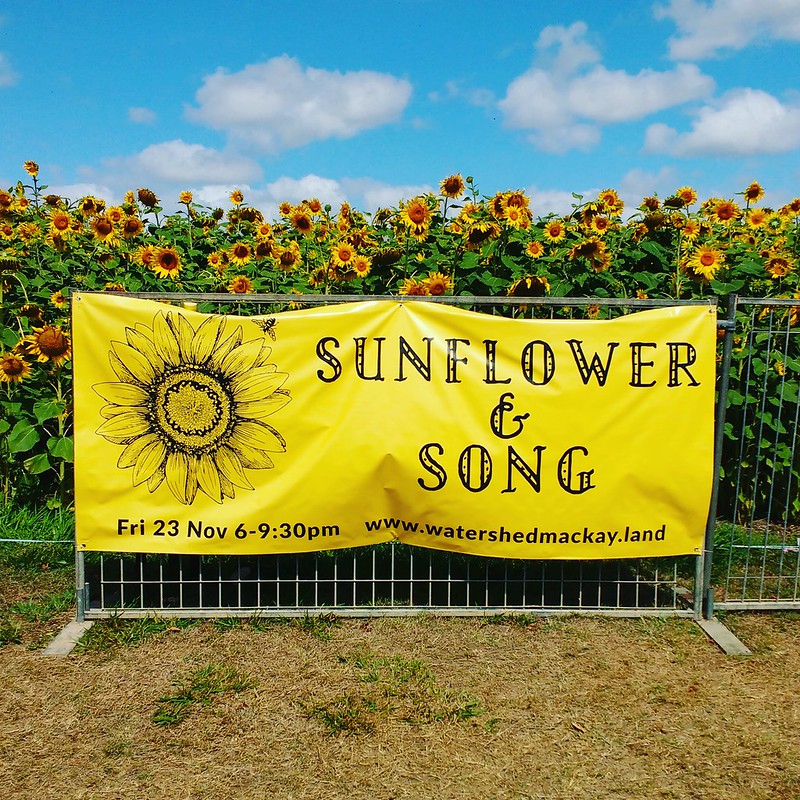Tylah Kinbacher, a young video maker from Mackay, produced this lovely video documenting our sugarcane harvest celebration in October 2019.

The Mackay Regional Botanic Gardens Land Art Project
Tylah Kinbacher, a young video maker from Mackay, produced this lovely video documenting our sugarcane harvest celebration in October 2019.
The wonderful Cherrie Hughes took these photos from the Old Ways New Ways sugarcane harvest celebration event on 4 October 2019. This is just a small selection – the full set of photos is available here.
This terrific article was written for the Weekly Times / Rural Weekly by Kirili Lamb, a journalist who has been following along for several months. You can read her previous articles about the Watershed Land Art Project here and here.
[Download a copy of the article as a PDF here.]
Continue reading “Cane, soil and water a good medium for art”
In the lead up to Old Ways New Ways, we visited my105 radio in Mackay for an interview with Charmaine Miller. Charmaine has followed our project ever since we planted the first legumes back in February 2018.
In the room: Starrett Vea Vea, who has been leading the engagement between the three communities (Australian South Sea Islander, Italian, and Maltese); Carmel Baretta, who is the president of the Mackay and District Italian Association, and is also of Maltese descent; and Kim Williams and Lucas Ihlein, both artists and co-ordinators of the Watershed Land art Project.
We had a great chat with Charmaine about the project and the sugarcane harvest celebration. You can listen to the interview here:
PS – on the same day, Carmel, Starrett, Kim and Lucas did another interview, this time on ABC radio with Tegan Philpott. There are two versions of the interview – one that ran on Friday (before the event) and one that ran on Saturday (after the event). You can check them out here:
Friday:
and
Saturday:
Old Ways New Ways – The Sugarcane Harvest
When: Friday, October 4, from 3pm to 7pm
Where: The Beacon – near the Meadowlands Amphitheatre, Mackay Regional Botanic Gardens
Cost: Free, all welcome. Kid-friendly event.
What to bring: a plate of food to share, a chair or picnic blanket, hats, sunscreen, water bottle.
More info: www.watershedmackay.land
Contact: Lucas Ihlein, 0423 745 736 or info@watershedmackay.land
Facebook event: https://www.facebook.com/events/651244108685011/
EVENT MEDIA RELEASE – PDF HERE.
AFTER two years growing at the Botanic Gardens, The Beacon’s chemical-free sugarcane crop is finally ready for harvest.
Join us on Friday, October 4 from 3-7pm at The Beacon, located at Mackay Regional Botanic Gardens, for our sugarcane harvest. The harvest event titled Old Ways New Ways is based on traditional cut-out celebrations, with everyone invited to bring a plate of food to share.
Old Ways New Ways is a celebration of the sugarcane families who for so many years have been the heart of Mackay (the “old ways”) as well as the growing movement of regenerative agriculture for soil health and human health (the “new ways”).
Come and learn about the way things were and be inspired by the way they’re heading to help our ecosystems flourish. Old Ways New Ways features a live cane harvesting performance, sugarcane juice, a shared meal, storytelling, science and movies.
The event will be launched by Stephen Andrew, MP for Mirani, Australian South Sea Islander descendent and a champion of regenerative agriculture.
Starrett Vea Vea, chair of MADASSIA, said that Old Ways New Ways was a great opportunity to bring cutting-edge ecological farmers of 2019 together with the cultures that built Mackay’s great sugarcane industry.
“It’s the first time that the Maltese, Italian, and Australian South Sea Islander groups have come together for a celebration like this,” he said.
Old Ways New Ways is a collaboration between the Mackay and District Australian South Sea Islander Association (MADASSIA), the Mackay Maltese Club Inc., the Mackay and District Italian Association Inc., and the team of artists and farmers behind the Watershed Land Art Project.
Artists Lucas Ihlein and Kim Williams have been leading the Watershed Land Art Project. The artists have had great success with community engagement around crops of legumes, sunflowers and sugarcane at The Mackay Regional Botanic Gardens over the last couple of years.
“Recent scientific tests indicate that the soil has benefited from the chemical-free multi-species cropping methods we’ve employed on site,” Lucas said.
“Regenerative farming is essential for both environmental and human health, and this project is an excellent demonstration of how innovations in sugarcane farming can have a positive effect on water quality in the Great Barrier Reef.”
Old Ways New Ways has been supported by the Mackay Regional Botanic Gardens, Regional Arts Development Fund (RADF), Reef Catchments, Catchment Solutions, Central Queensland Soil Health Systems, University of Wollongong, Yuwibara traditional owners, and a whole host of community participants!
On May 29, 2019, scientists at Catchment Solutions performed a Rainfall Simulation Trial at The Beacon, Mackay Regional Botanic Gardens. The results tell a great story for soil improvement associated with our project! (Scroll to bottom of this blog post for some caveats associated with these results).
You can read the full PDF report here.
In the Background information associated with the report, Catchment Solutions describes The Beacon as a small demonstration farm showcasing regenerative agriculture methods:
“The Beacon project is associated with the ‘Watershed Land Art’ program and is situated at the Mackay Regional Botanic Gardens. ‘The Beacon’ is a 26-metre diameter demonstration farm at the Botanic Gardens, showing how diverse plant species can be incorporated into sugarcane production.
The project received funding from two sources: The Great Barrier Reef Marine Park Authority (GBRMPA), through their Reef Guardians program; and the Queensland Regional Arts Development Fund (RADF), through its “Green Arts” program. Funding for the rainfall simulation assessment has been provided by Reef Catchments Limited.
The Beacon, is a small “demonstration farm” – not only trialling and showcasing a range of methods which will help build soil, reduce chemical use, and cut down on the run-off which travels from the land out to the reef, but also testing out how land management can be done in a respectful, inclusive and cross-cultural way.”
The scientific trial involved bringing apparatus on site which “rains” onto the soil at The Beacon at a particular rate, in order to simulate a heavy tropical rainfall event. The reason we did this test was to find out how well our soil can hold water and resist run-off.
Since early 2018 we’ve been building the soil with regenerative farming methods – legumes, cover crops, multi-species plantings, mulch, minerals, and microbes – all carried out with community participation on public land at the Botanic Gardens.
The team from Catchment Solutions rained water onto The Beacon, and onto a patch of nearby grassland (as a control) at the rate of 70mm/hour for 30 mins. They then compared the run-off rate between the two sites.
There are lots of details in the report, about sediments and chemicals, and you can explore the full report here.
In the conclusion, the report states:
“The Beacon plot (with regenerative farming practices) demonstrated a marked reduction in nutrient and pesticide loss, when compared to run-off results from trashed blanketed conventional farming systems (post 100 days application). Very low-level residual pesticide run-off results were found at the two plots for Atrazine and Imidacloprid, which may be associated with historical pesticide usage.Due to the lack of plot replication and an appropriate farmed control site, there is a degree of uncertainty with respect to the findings. Comparisons are limited to the two test lots and rainfall simulation findings may be influenced by historical impacts (e.g. residual pesticides).”
This is excellent news, and confirms what the regenerative farmers we’ve been working with have believed all along.
CAVEAT:
Importantly, this was a one-off test and would need to be replicated with more thoroughness before it could be seen as definitive of the soil improvements that have taken place at The Beacon. The team at Catchment Solutions have added these statements as a caveat:
“Due to the lack of plot replication and an appropriate farmed control site, there is a degree of uncertainty with respect to the findings. Comparisons are limited to the two test plots and rainfall simulation findings may be influenced by historical impacts (e.g. residual pesticides).
The control site was the adjacent lawn area and not a farm site.This trial was very much a high level demonstration (with the water quality monitoring component a rather late add-on) and a more detailed scientific and rigorous trial design would be necessary before more definitive conclusions were made.”
Many thanks to the staff of Catchment Solutions and Reef Catchments for supporting this trial.
This article appeared as a feature in the Rural Weekly on 10 May 2019. It’s based on the wisdom of John Sweet, one of the visionaries behind the Watershed Land Art Project. Great hat, John!
The article is by Kirili Lamb.
You can read the article here combined into one page, or as two separate pdf pages here: left page, right page.
Beacon For Agriculture: Secret is the letter M.
Cattleman John Sweet talks Minerals Mulch and Microbes
– Article and photos by Kirili Lamb.
JOHN Sweet reckons if people implemented regenerative techniques into their land management, there may not have been cause to strengthen reef protection regulations.
And it all begins with the right mix of the three Ms: minerals, mulch and microbes.
“It’s the basis of all biological farming. If you get those right, after about two years, you don’t need any toxic biocides,” he said.
“Once you get the minerals in the soil balanced, using lime and rock dust, you find the weeds go away.
“You do those three things – minerals, mulch and microbes – and you get lower input costs, better production, and you don’t get toxicity around the farm.”
John has developed an action plan for managing land and water quality in Great Barrier Reef catchments, which he sees as a national emergency. He alludes to Franklin D Roosevelt’s declaration in the US mid-west Dust Bowl era, that “the nation that destroys its soil destroys itself”, and says this also applies to the reef, and to human health, in today’s Queensland.
“There’s a lot of people wanting to change their farming habits, which needs to happen across the board, and there are a lot of farmers not quite sure where to start,” he said.

John was born out in the black soil country of Blackall, and at 82, he’s a retired cattleman, the former steward of Rugby Run station on the Central Highlands, where he cut his teeth on regenerative land management practices.
For John, the start of his regenerative learning began with a visit as an 18 year old in the 1950s to regenerative farming pioneer PA Yeomans’ property Nevallan, west of Sydney. Inspired by the practices and inventions he saw, and deploying these on his own property, the 11,800ha Rugby Run, John and PA Yeomans later worked together on refining keyline design implementation in the 1980s.
“In the last years of his life, PA came to Rugby Run three or four times a year and worked there for five years. We put in a drought-proofing system, and it is so perfect.
“He was very ill at the time, but it really revived him. He’d sometimes tell his wife Jane ‘I’ve just had a call from John at Rugby Run, I’ve got to go up there again’. But I hadn’t even phoned him!
“I got my experience in soil from him. We used to sit up until two in the morning. I’d argue with him, ‘but that won’t work!’, but he was always absolutely right, every time.”
Before keyline water management earthworks on Rugby Run, water had barrelled off the site.
The site also implemented keyline grass shock methods, where grass/legume mix cover is cut or grazed just prior to going to flower. The shock causes a die-back, feeding beneficial soil microbes, and then regenerating pasture and in-soil organic matter.
“For a cover crop, you should always use grasses and legumes: PA Yeomans travelled the world, going to all the fertile areas like the Pampas, the Great Plains, the Darling Downs, out here in the Central Highlands, and in the old days, maybe 50 or 60 years ago, all those fertile areas had grasses and legumes growing together in the fertile soil,” John said.
“He figured out that if you are working with nature, you need to use both.
“When you do this grass shock, you increase humus levels as well as carbon. When you get your humus levels up, it’s been shown by a lot of research and practical stuff, that you need 30 to 40 per cent less irrigation water, because the humus holds that water into the soil rather than losing it.”
John said these results had application in cane growing, and growers who had remediated soil minerals, microbes and mulch were seeing positive results around water retention and input demands.
“If cane farmers get the humus in the soil and re-structure their water, they are way ahead,” he said.
In retirement, John shares a curated forest at Netherdale in the Pioneer Valley with wife Christene, and is a member of the Central Queensland Soil Health Systems group, and a member of the Local Marine Advisory Committee for the past 11 years.
He is passionate about educating the community, including farmers and graziers, about regenerative land management.
John points to the successes being shown by cane farming members of CQSHS who are deploying a range of measures, including, but not limited to, use of bio-dynamic teas on crops, water re-structuring, multi-species assembly and break plantings.
The group’s demonstration site, The Beacon, uses multi-species methods used by various members of the grassroots farmers group, and has so far seen significant soil de-compaction and aluminium reduction, along with a soil carbon boost from 2.3 to 2.7 per cent in just 10 months.
“It’s quite possible, using what we did at The Beacon, and with other regen ag efforts like biodynamics, to raise carbon levels from 2 per cent up to being very conservative, maybe 6 per cent.
“I had it up to 8 per cent out on Rugby Run.”
This wonderful article came out in the Rural Weekly about The Beacon at the Mackay Regional Botanic Gardens.
Thanks to journalist Kirili Lamb for making this happen, and to John and Christene Sweet for getting this bunch of legends together for the photo shoot! Featured in the photo are Christene and John Sweet, Robert Bole, Ray Abela, Arthur Grech, (front) Deb McLucas, Sharon Dallas, Kevin Kay, Michael Attard and George Tonga.
I’ve pasted below the text from the article:
Group a beacon shining bright with ideas
CENTRAL Queensland Soil Health Systems has been successfully demonstrating the productivity of biological, regenerative on-farm land management systems as a group for the past five years, building on years of individual work and experience of members.
Mostly working across commercial cane and livestock, the group has 33
members, whose operations deploy a range of principles including biodynamics, permaculture, keyline, organics and natural sequencing.
CQSHS is in the process of applying for round two funding to the Great Barrier Reef Foundation Fund, aiming to establish 30 demonstration sites on cane farms in identified water quality hotspots in the Plane Creek and Mackay growing districts, utilising the group’s approaches.
The group is currently spearheading The Beacon demonstration site on the grounds of Mackay Regional Botanic Gardens, which was planted initially with mixed legumes, followed by a co-planting of sunflowers and sugar cane.
Sunflowers were mulched in November, leaving the cane.
The site integrates as a Watershed Arts Agriculture installation work led by Lucas Ihlein and Kim Williams, integrating film, song and photographic elements to communicate regenerative farming ideas to both cane farmers and the broader community.
Our Sugar vs the Reef? exhibition at Artspace Mackay recently ended, and we have lots of stuff to share from that show.
Here’s a video snapshot of the SEED & SONG planting day from August 2018 at the Mackay Regional Botanic Gardens. On that day, a host of collaborators came together to sing, dance, eat, drink, and plant sugarcane and sunflowers.
Local film maker Willem Reichard shot the footage, and our friends from Wayward Films edited it together.
The song which weaves throughout the video is “The Planting Song” by Kim Williams, which she has been developing over the course of the whole project. It started as “The Legume Song” (when we planted legumes in February 2018), and later (in November 2018) became “The Harvest Song” – same melody with an ever-evolving lyric sheet!
This version was recorded by the wonderful Dave Sheldon at Tin Shed Studio in Mackay, with the voices of Fiona, Oni and Alec Vuibeqa, Susie and Sophie Mattsson, and of course Kim and Lucas.

In the evolution of any botanical project, things live and die. Different species have different lifespans, and each has its moment to shine before moving aside to make space for the others.
Continue reading “Sunflower & Song Reflections”